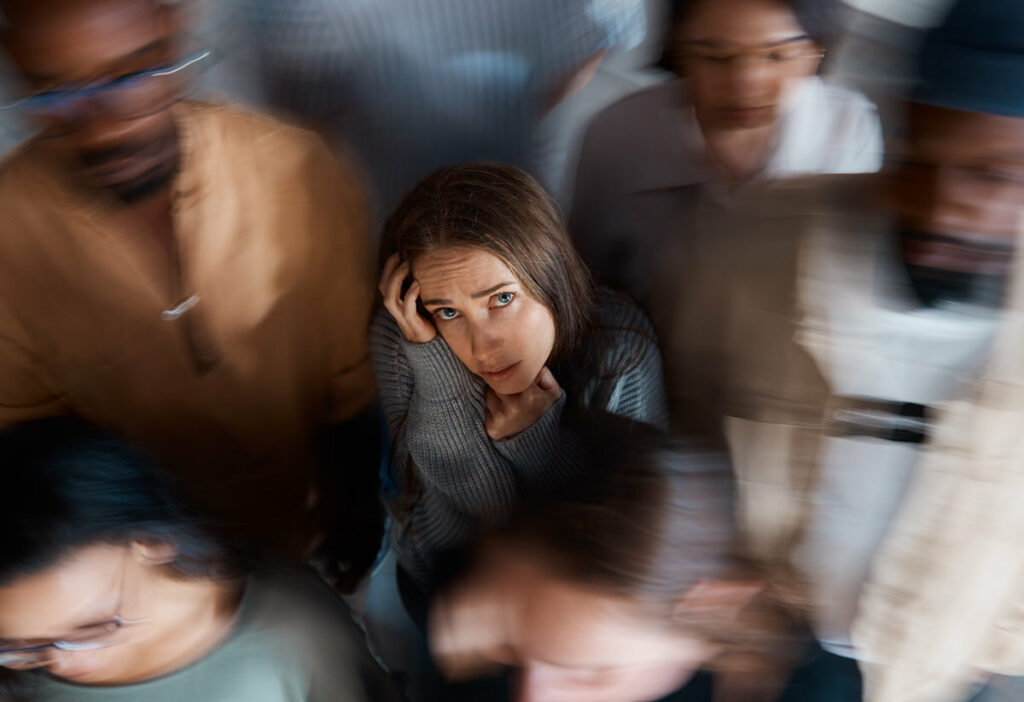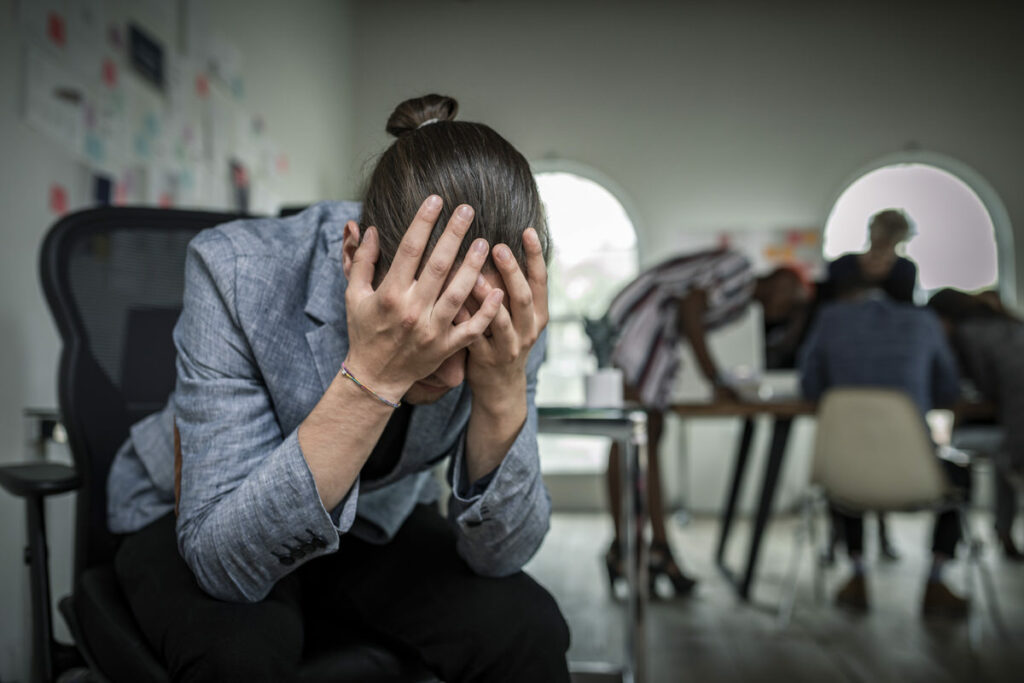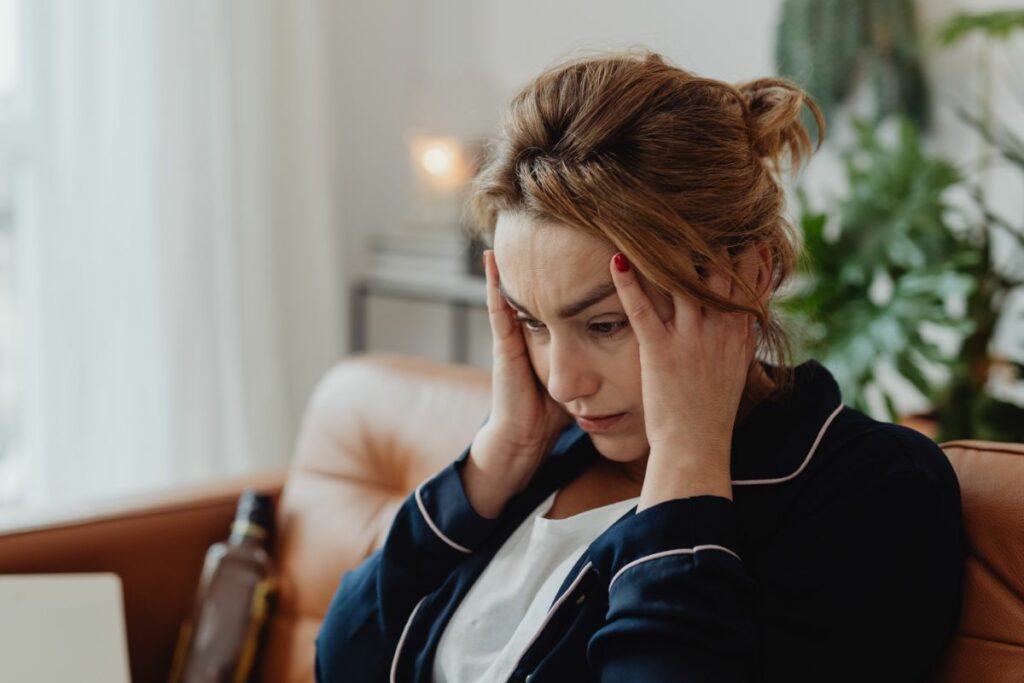Social anxiety, more than just shyness, is a chronic fear of judgment in social situations, leading to symptoms like sweating, blushing, and nausea. It typically starts in youth and is influenced by genetics, environment, and personal experiences. Effective management includes Cognitive Behavioral Therapy, medications, and lifestyle changes, focusing on altering negative thoughts and behaviors. Understanding and accepting social anxiety is crucial for progress, with professional help and support groups providing significant assistance. While it may not completely go away, its impact can be greatly reduced.
Social anxiety is more than just shyness or a momentary flutter of nerves before speaking in public. It’s a pervasive disorder that can cause intense fear and discomfort in everyday social interactions, even those as simple as making eye contact or eating in front of others.
Understanding the stages of social anxiety can help you identify if what you’re experiencing is part of this condition, paving the way for effective coping strategies or treatment.
At its core, social anxiety is marked by a chronic fear of being judged or embarrassed in social situations. This fear can manifest in varying degrees, from mild apprehension in certain scenarios to debilitating anxiety that interferes with your daily life.
Recognizing the symptoms and impact of social anxiety is the first step in seeking help, as timely intervention can significantly improve your quality of life.
The 3 stages of social anxiety
Here, we delve into each stage and offer practical strategies to empower you on your journey towards managing social anxiety effectively.
1. The Anticipatory Stage
The anticipatory stage is a period of heightened anxiety and worry that occurs before a social event or interaction. It’s characterized by the fear of what might happen, often leading to overthinking and stress about potential social scenarios.
Actionable Tips:
- Mindfulness Practice: Engage in mindfulness techniques to stay present and reduce worrying about the future. This can involve deep breathing exercises or focusing on your current surroundings.
- Positive Visualization: Spend a few minutes daily visualizing a successful social interaction. Imagine yourself being calm, confident, and enjoying the company of others.
- Preparation and Rehearsal: If you’re worried about a specific event, try rehearsing conversations or actions. Familiarity can reduce anxiety.
2. Situational Exposure
Situational exposure involves the actual experience of being in a feared social setting. During this stage, individuals may feel acute anxiety and fear, worried about being judged or scrutinized by others.
Actionable Tips:
- Gradual Exposure: Start by placing yourself in less challenging social situations and progressively work your way up to more anxiety-inducing ones. This can help desensitize your reactions over time.
- Coping Statements: Have a set of positive affirmations or coping statements ready. For example, remind yourself that “I can handle this situation” or “My anxiety does not define me.”
- Seek a Support Buddy: If possible, attend social events with a trusted friend who understands your situation and can provide support.
3. Post-Event Processing
This stage occurs after a social event, where individuals may ruminate over their performance.
Often, there’s a focus on negative aspects or perceived flaws in their interactions, which can reinforce social anxiety.
Actionable Tips:
- Reflective Journaling: Write about your experiences post-event, focusing on both what went well and areas for improvement. This can help shift your focus from negative to more balanced reflections.
- Objective Analysis: Challenge yourself to identify objective facts about the interaction instead of subjective feelings. Ask, “What evidence do I have for and against my negative thoughts?”
- Feedback and Learning: If comfortable, seek feedback from a trusted person who was present. Use this as a learning opportunity rather than a critique of your social skills.
By understanding these stages of social anxiety – anticipatory stage, situational exposure, and post-event processing – you gain a more comprehensive view of how social anxiety unfolds and how to manage it effectively.
Remember, each stage offers an opportunity for learning and growth.
With patience and practice, you can navigate these stages with increasing confidence and reduce the overall impact of social anxiety on your life.
Understanding social anxiety

This section will help you recognize the complexities of social anxiety, differentiate it from ordinary shyness, and identify early signs that may often go unnoticed.
Social anxiety and its significance
Social anxiety is more than just feeling nervous; it’s a persistent fear of being watched or judged by others in social interactions.
This condition, also known as social phobia, can significantly disrupt daily life, making it challenging to engage in everyday social situations, such as starting conversations, attending social gatherings, or even making eye contact.
Understanding the importance of recognizing and addressing social anxiety is crucial for improving quality of life.
Distinguishing between shyness and social anxiety disorder (SAD)
While shyness is a common trait that many people exhibit, it’s not the same as social anxiety disorder (SAD).
Shyness is typically a personality characteristic characterized by feeling uneasy or timid in new situations or with unfamiliar people, but it doesn’t usually interfere with one’s daily functioning.
On the other hand, social anxiety disorder is a recognized mental health condition where your fear and anxiety become overwhelming, frequently leading to avoidance behaviors and severe distress.
Early signs that often go unnoticed
Some early indicators of social anxiety can be subtle and easily overlooked.
📌 For example, you may frequently avoid eye contact, stay quiet in group settings, or experience physical symptoms like blushing, sweating, or trembling in social environments.
These signs, even though they seem minor, can escalate and become debilitating if not acknowledged and managed promptly.
Causes and risk factors

Understanding the causes and risk factors of social anxiety can empower you to grasp why it might affect you or your loved ones. This vital awareness is your first step towards addressing the disorder.
Genetic and environmental influences
Genetic Factors play a significant role in social anxiety. If a close family member struggles with social anxiety, you have a higher risk of experiencing similar issues.
This genetic predisposition, as highlighted by Mayo Clinic, suggests that social anxiety disorder may be partially heritable.
The environment you grow up in also significantly affects your risk.
Environmental factors, such as a history of negative social experiences or family environments that model anxious behavior in social situations, can contribute to the development of social anxiety.
Temperament and life experiences
Your temperament, or natural predisposition, might make you more prone to social anxiety. If you’re naturally reserved or shy, particularly as a child, you might be more sensitive to social situations as you grow.
Life experiences, including bullying, family conflict, or trauma, can also increase your susceptibility.
Such experiences may shape how you perceive social interactions and dictate your comfort level in social settings later in life.
Social anxiety typically begins during youth, and symptoms can manifest as fearfulness in new situations or when you are the center of attention.
These experiences during critical developmental stages can alter your long-term ability to cope in social settings.
Signs and symptoms of social anxiety
Social anxiety can manifest in a variety of ways that affect both your body and mind. It’s important to recognize the signs so you can seek appropriate help.
Physical and behavioral indicators

Physical symptoms often accompany social anxiety. When you’re in a situation where you feel judged, you might experience:
- Sweating: A common reaction to nervousness or fear.
- Blushing: Your cheeks may become flushed due to increased blood flow.
- Nausea: You might feel queasy or experience stomach discomfort.
These symptoms can be accompanied by a strong urge to avoid social situations that may cause you distress.
Emotional and cognitive manifestations

Social anxiety also impacts your emotions and thoughts. You might find yourself dealing with:
- Negative thoughts: Expecting the worst possible outcomes in social interactions.
- Self-consciousness: Overwhelming feelings of being watched and judged by others.
Remembering these signs and being aware of their impact on your life can be the first step towards managing social anxiety.
Impact on your daily life
If you live with social anxiety disorder, the effects can permeate through all aspects of your life.
It can hinder your performance where you need to be at your best, like at work or school, and strain the personal connections that enrich your days.
Effects on work and school performance
Your work and school environments demand consistent performance, participation in meetings, and often public speaking.
Social anxiety can make these expectations daunting. For example, you might find yourself avoiding presentations or group projects due to a fear of judgment or negative evaluation from others.
This anxiety can manifest as physical symptoms like shaking or a racing heart, impacting not only how you feel but also how you function under scrutiny.
Improving your work and school experience starts with recognizing these challenges and seeking strategies to manage your anxiety in professional and educational settings.
- Meetings: Might avoid participating or feel extreme discomfort.
- Presentations: Often associated with intense fear of scrutiny.
- Performance: Can decline if fear leads to avoidance of key tasks.
Influence on personal relationships and social interactions
Social anxiety doesn’t just stay at work or school; it follows you home and into your personal life.
This condition can cause a withdrawal from social activities and strain relationships, as making and maintaining connections feels overwhelming. You might notice a reluctance to meet new people or decline social invitations.
These patterns can lead to feelings of loneliness and can decrease your overall quality of life.
Prioritizing self-care and communication techniques can help to bolster your confidence in social settings.
- Social invitations: Often declined due to fear of social situations.
- Making friends: Can be challenging due to fear of initiating conversations.
- Quality of life: May decrease if isolation persists.
By acknowledging the impact social anxiety has on your daily activities, you can begin to take steps toward managing its effects.
Treating your social anxiety
When addressing social anxiety, it’s important to know that you have a variety of options for treatment and management that can be tailored to your individual needs.
Consider therapy options
Therapy represents a cornerstone of treatment for social anxiety.
Cognitive Behavioral Therapy (CBT) is among the most effective, focusing on altering negative thought patterns and behaviors.
Exposure therapy, a subset of CBT, may also be beneficial as it gradually introduces you to anxiety-inducing situations in a controlled way to decrease fear over time.
For more detailed therapies, the Mayo Clinic offers comprehensive insights.
Accepting its presence
Understanding and accepting that you experience social anxiety is a vital step toward effective management.
Acceptance can reduce the pressure you put on yourself and pave the way for a more focused approach to therapy and treatment.
Compassionate self-awareness helps in tracking your progress and acknowledging the small victories along the path to better managing your anxiety.
Medication and alternative treatments
In some cases, medications are used in conjunction with therapy to treat social anxiety.
Selective serotonin reuptake inhibitors (SSRIs) are commonly prescribed antidepressants that can help manage anxiety symptoms.
Benzodiazepines might also be used, though usually with caution due to their potential for dependency.
📌 Please note that while we do our best to share this information, we highly recommend you speak to your doctor when it comes to medication and alternative treatments.
Long-term management and coping strategies
Managing social anxiety is often a long-term pursuit.
Developing coping strategies, such as deep breathing, meditation, or exercise, can provide relief in anxiety-provoking situations.
Building a solid support system and practicing self-care are also key components for lasting success.
Long-term management is built on a foundation that includes both professional help and self-help strategies.
Ongoing management of your social anxiety
Social anxiety can be a complex condition, but with the right approach, you can learn to navigate social situations with greater ease.
The following strategies are designed to help you at different stages of social anxiety, whether you’re seeking self-help techniques or considering professional assistance.
Practical tips and techniques for each Stage
For initial encounters with social anxiety, breathing exercises, and mindfulness practices can be immediate go-to techniques to help reduce the physical symptoms of anxiety.
When feeling socially anxious, use the step-by-step approach to break down the situation and apply coping strategies accordingly.
Self-help strategies and lifestyle changes
Managing social anxiety isn’t just about therapy and medication; it also involves integrating self-help strategies and positive lifestyle changes into your daily routine.
These methods can empower you to take control of your anxiety and improve your overall well-being.
- Journaling for reflection and awareness:
- Start by dedicating a few minutes each day to journaling.
- Write about your daily experiences, focusing on situations that trigger your social anxiety and how you respond to them.
- Reflect on patterns and triggers, and note any progress or setbacks.
- Use the journal as a safe space to express feelings you might not be comfortable sharing with others.
- Developing assertiveness skills:
- Practice expressing your thoughts and needs clearly and respectfully.
- Begin with small, low-risk situations, like asking for a specific item at a restaurant or expressing a preference in a group setting.
- Role-play with a trusted friend or family member to build confidence.
- Remember, being assertive is about respecting both your own rights and those of others.
- Regular exercise for stress relief:
- Incorporate a routine of regular physical activity, tailored to your fitness level and interests. This could be anything from walking or jogging to yoga or team sports.
- Aim for at least 30 minutes of moderate exercise most days of the week.
- Focus on activities you enjoy and give you a sense of achievement.
- Notice how exercise can reduce feelings of anxiety and improve mood.
- Adopting a healthy diet:
- Eat a balanced diet rich in fruits, vegetables, whole grains, lean protein, and healthy fats.
- Limit caffeine and sugar intake, as they can exacerbate anxiety symptoms.
- Stay hydrated and avoid skipping meals, as low blood sugar levels can increase feelings of anxiety.
- Consider keeping a food diary to track any correlations between your diet and anxiety levels.
- Creating a supportive environment:
- Surround yourself with supportive people who understand your challenges with social anxiety.
- Communicate your needs and boundaries to friends and family.
- Join support groups or online forums where you can share experiences and learn from others who are facing similar challenges.
- Establishing a relaxation routine:
- Incorporate relaxation techniques such as deep breathing exercises, meditation, or mindfulness into your daily routine.
- Create a calm and comfortable space in your home where you can retreat to relax.
- Explore different relaxation methods to find what works best for you, and practice them regularly.
By combining these self-help strategies and lifestyle changes with professional treatment, you can create a comprehensive approach to managing social anxiety.
The key is to be patient with yourself and recognize that managing anxiety is a gradual process, but with consistent effort, significant improvement is achievable.
Social anxiety-specific forums and support groups (online)

There’s help online, too. You can connect with support or peers in support groups and online forums.
Support groups
- Facebook groups – You can find many support groups on Facebook. Join 2-3 groups at a time to see which one helps you the most.
Online forums
- https://www.socialanxietysupport.com/forums/
- https://www.mentalhealthforum.net/forum/forums/social-anxiety-forum.44/
FAQs
What are the common symptoms of social anxiety disorder?
You may experience symptoms like intense fear of social situations, worry about embarrassment, and physical signs such as blushing, sweating, or a trembling voice.
These symptoms can be persistent and very distressing.
Can social anxiety be considered a mental illness?
Yes, social anxiety is recognized as a mental health condition where you have an extreme fear of being negatively judged or rejected in social situations.
How does social phobia impact daily life and relationships?
Social phobia can significantly disrupt your daily life, making routine activities like going to work or school stressful. It might also affect your relationships by causing you to avoid social interactions.
What factors can exacerbate or worsen social anxiety?
Stressful life events, environmental factors, and certain personality traits can worsen social anxiety. Over time, avoidance behaviors may reinforce the fear, making the disorder more intense.
What treatments are available for social anxiety disorder?
There are effective treatment options, including cognitive-behavioral therapy, and sometimes medications, like SSRIs or beta-blockers, to manage symptoms.
How can someone with social anxiety manage their condition in social situations?
Learning relaxation techniques, practicing assertive communication, and gradually facing social situations can help you manage symptoms of social anxiety in day-to-day interactions.
Can social anxiety develop at any age?
Although it often begins in adolescence, social anxiety can develop at any age. It may be linked to a history of negative social experiences or life transitions that increase social demands.
Is It Possible to Overcome Social Anxiety Without Professional Help?
Some individuals may find strategies to cope with social anxiety on their own using self-help methods, but professional guidance can be crucial in managing more severe cases.
How Can I Support Someone with Social Anxiety?
Encourage them to seek help, be patient, and offer understanding. It’s important to support them in taking small steps towards managing social situations without forcing them into uncomfortable scenarios.
References
- https://www.mayoclinic.org/diseases-conditions/social-anxiety-disorder/symptoms-causes/syc-20353561
- https://www.nimh.nih.gov/health/publications/social-anxiety-disorder-more-than-just-shyness
- https://www.helpguide.org/articles/anxiety/social-anxiety-disorder.htm
- https://adaa.org/understanding-anxiety/social-anxiety-disorder
- https://psychcentral.com/anxiety/cycle-of-anxiety


